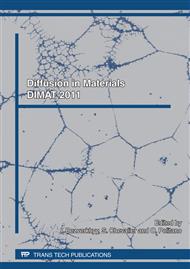p.95
p.101
p.109
p.115
p.121
p.127
p.133
p.139
p.149
Modeling of Fractional Diffusion on a Catalytic Particle under Different Flow Conditions
Abstract:
Coupling diffusion and convection of species is relevant for optimization of diverse engineering processes, especially when chemical reactions are involved. In particular, the problem of predicting the flow of species into a particle is of large importance in the design of catalytic particles. A numerical framework using the Least Squares Spectral Element Method is implemented in order to analyze the species transport from a flow into a particle by a fractional constitutive law. The aim of this work is to investigate the qualitative change in the concentration profiles in the transition from Fickian to fractional anomalous transport inside the particle. A sample case is provided corresponding to a flow between two parallel plates and around a cylinder, coupled with species transport into the cylinder.
Info:
Periodical:
Pages:
121-126
Citation:
Online since:
April 2012
Authors:
Price:
Сopyright:
© 2012 Trans Tech Publications Ltd. All Rights Reserved
Share:
Citation:


